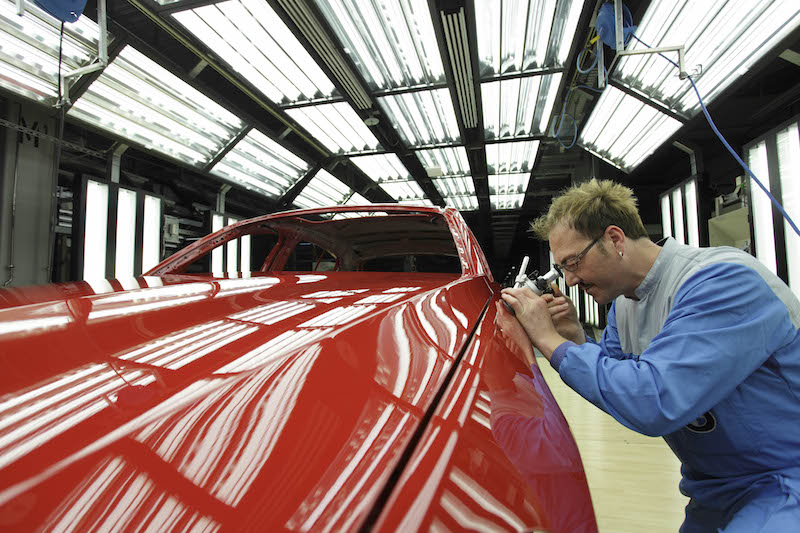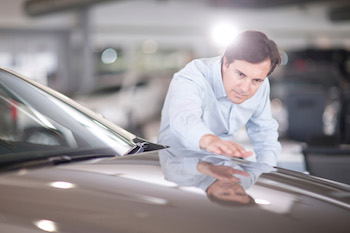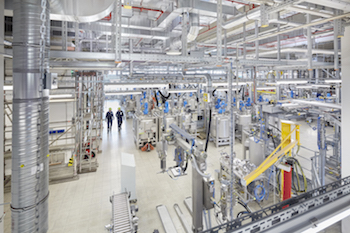As vehicle-makers add more innovative materials in body construction and change their production processes to meet new environmental regulations, paint suppliers are striving to match their requirements The majority of consumers take them for granted, but exterior coatings have to cover a lot of ground. Ray Schappert, global director of product management for PPG Automotive OEM Coatings, says: “Automotive OEM coatings need to be tough enough to withstand the daily abuse inflicted upon modern vehicles. From kids rubbing dirt on their parents’ vehicles, environmental exposure, exposure to salt and corrosive situations, to door dings, the coating must maintain adhesion and resist scratches.” He summarises: “The coating must be durable enough to last the life of the vehicle, ten to 15 years, without fading.”
The majority of consumers take them for granted, but exterior coatings have to cover a lot of ground. Ray Schappert, global director of product management for PPG Automotive OEM Coatings, says: “Automotive OEM coatings need to be tough enough to withstand the daily abuse inflicted upon modern vehicles. From kids rubbing dirt on their parents’ vehicles, environmental exposure, exposure to salt and corrosive situations, to door dings, the coating must maintain adhesion and resist scratches.” He summarises: “The coating must be durable enough to last the life of the vehicle, ten to 15 years, without fading.”
Further to these functional requirements, exterior coatings must be attractive and – increasingly – distinctive, according to Wolfgang Reckordt, BASF’s head of marketing Automotive Coatings Solutions Europe, Middle East and Africa (EMEA): “It is important that the colour fits the brand image of the OEM, the car itself, as well as the current trends. Support of design elements and a long-lasting gloss are further essential contributions for a ‘brand-new look’.”
In light of these diverse requirements, it is hardly surprising that exterior coating processes are lengthy and expensive to carry out. In traditional automotive painting, the application of a pretreatment and an electrocoat (e-coat) is followed by a primer. After the primer is cured, a topcoat and a clearcoat are also applied and cured. The process can take upwards of 12 hours and the paintshop can account for over 60% of a plant’s total energy consumption.
“It is important that the colour fits the brand image of the OEM, the car itself, as well as the current trends” – Wolfgang Reckordt, BASF
Moreover, this process can produce vast quantities of wastewater, paint solids and volatile organic compounds (VOCs), which OEMs are under pressure to reduce, both from regulatory bodies and from their customers. Schappert explains: “Automotive OEMs are demanding more efficient paint processes that save capital, reduce water and energy usage, and minimise materials costs.”
As a result, the big three paint suppliers – PPG, BASF and Axalta Coating Systems – have all developed more compact painting processes, and are increasing their production of water-based coatings over those based on solvents. In North America and Europe, many OEMs have already converted their assembly plants to water-based primers and basecoats in order to lower VOC emissions, and this practice is also increasing in Asia.
– In addition to providing a durable finish, paints must create attractive aesthetics – and, increasingly, brand-related distinctiveness
– Today’s OEMs and consumers both have higher environmental awareness than in the past, requiring suppliers to develop products which are eco-friendly in the plant as well as outside it
– Coatings suppliers are helping OEMs to compress their paint processes, saving on costs and resources
– Vehicle lightweighting and the associated use of mixed materials in body construction is throwing up application challenges for paintshops and paint providers
– As vehicle-makers have moved toward local production, paints suppliers have also become more global

Compressing the paint processSchappert continues: “PPG has developed a compact paint system that allows the OEM to eliminate the primer layer and the associated primer application booth and bake oven.” Using this waterborne process – known as B1:B2 – the first basecoat layer (B1) acts as the primer, which provides filling and chip resistance and demonstrates sufficient opacity to protect the system from damaging wavelengths of light radiation. The second (B2) layer imparts the final colour and increases the durability of the coating. Both B1 and B2 protect the e-coat layer. B1 and B2 are applied wet-on-wet, and afterwards the vehicle continues along the paint line as it would in a traditional layout.
“This new paint system provides the OEMs with lower costs from a smaller paintshop footprint, reduced energy consumption and in some cases can increase the paint booth capacity, further increasing the appeal,” says Schappert.
In 2004, the first generation of B1:B2 was launched in Europe and used by BMW at its Mini plant in Oxford, UK, where it saved energy and reduced the paintshop's greenhouse gas emissions by over 10%. B1:B2 enabled BMW to allocate the space and infrastructure previously taken up for the application of the primer coat to the installation of an additional basecoat line, helping the plant to ramp up its production capacity. BMW must have been satisfied with the result, as in January 2010 the second generation of the B1:B2 paint technology was successfully launched in the US at the OEM’s assembly plant in Spartanburg, South Carolina.
BASF’s Reckordt says: “There is clearly a trend towards sustainability in various areas of the automobile industry. The awareness for the environment is growing among society as well as among the OEMs. BASF contributes to climate protection with innovative solutions such as Integrated Process II, which eliminates one process step and this way reduces the energy consumption.”
With Integrated Process II (IP II), much like B1:B2, the functionality of the primer is integrated into a waterborne basecoat layer, which enables energy consumption in the paintshop to be reduced by 15-20%, according to BASF. The company's CathoGuard 800 e-coat can be used as part of IP II. The cathodic coating is free of tin and contains less than 1% solvents, guaranteeing compliance with European environmental legislation. Furthermore, BASF claims that the product coats the body of the car more evenly, with a more homogenous thickness, than other e-coating technologies and therefore results in 25% material savings and a significant reduction in cost for OEMs. The e-coat has been adopted by General Motors (GM) – at its plants in Russia, China, Brazil and North America – and by Volvo Trucks in Sweden.
“Automotive OEMs are demanding more efficient paint processes that save capital, reduce water and energy usage, and minimise materials costs”– Ray Schappert, PPG
Axalta Coating Systems has taken a slightly different approach in its attempts to reduce the complexity of the conventional coating process. In the 2-Wet Monocoat paint system – first adopted by Ford at its Kansas City Assembly Plant for the painting of the Transit – a primer is applied that requires only a few minutes of open-air drying time. Then the colour coat, formulated to provide the same aesthetics as a traditional colour coat but providing the protection of a clearcoat, can be applied. Afterwards, the painted body is cured in an enamel oven. Coating applications are reduced from three to two and the number of drying steps from two to one in comparison with conventional processes.
Ford tested the resultant finish for resistance to chipping and scratching, pollutants and sun exposure. Advanced weathering tests indicated that paint applied with the technology retains 90% of its gloss after four years in service compared with 1% gloss retention for paint applied using a conventional monocoat process. Furthermore, the process uses less energy and water – saving Ford money – and reduces CO2 and particulate emissions compared with conventional paint processes. According to the OEM’s initial estimates, the reduction in paint and energy cuts CO2 emissions by 9,500t and particulate emissions by 35t on an annual basis.
 Ford's aluminium-bodied F-150 is an example of the new materials which are creating challenges for paint providers
Ford's aluminium-bodied F-150 is an example of the new materials which are creating challenges for paint providersAdapting to mixed-material vehiclesAt the same time as demanding more efficient processes, many OEMs are changing the materials they use to produce their vehicles. In 2014, Ford switched from steel to aluminium for the production of the body of its market-leading F-150. Several premium OEMs – notably BMW, Cadillac and Audi – are pioneering the use of a mixture of carbon-fibre-reinforced plastics (CFRP), aluminium and steel for the manufacture of their vehicle structures. Reckordt says: “Depending on the substrate used – either purely aluminium alloys or a combination – individual coatings solutions are required. This affects all layers: e-coats and spray coats have to be adapted to the respective process parameters in order to fulfil high quality demands.”
In particular, the increased use of aluminium in a car body leads to an increase in the amount of sludge generated during the zinc phosphate pretreatment process. This sludge remains in the dip tanks and can clog circulation pumps – causing costly downtime – and can lead to rough surfaces and paint adhesion issues. Schappert says: “PPG has developed a family of pretreatment products that are specifically designed for high-aluminium-content and other mixed-metal vehicles. PPG’s Zircobond pretreatment can handle high-aluminium-content vehicles, up to 100% aluminium, while reducing the waste products associated with pretreating aluminium by 90% when compared with traditional zinc phosphate pretreatments.”
PPG has also developed a drop-in pretreatment technology that requires no system modifications to the traditional automotive paintshop. Called Versabond, the pretreatment is a kinetic, microcrystalline, tri-cation phosphate coating that can handle up to 60% aluminium content on vehicles, such as those with aluminium skins on doors, hoods and deck lids. This technology also improves the corrosion resistance of aluminium compared with conventional methods, and reduces waste generation and associated maintenance by up to 50%, according to the company.
“Lightweight vehicle construction is definitely driving innovation in low-bake coatings” – Sven Radek, Axalta
CFRPs can be particularly difficult to paint. CFRP substrates tend to be rough and porous, and their electrical conductivity is not uniform, which can lead to an inconsistent finish using electrostatic painting systems. Furthermore, they may not be compatible with high-temperature baking. Speaking at the European Automotive Coating Conference, held in Bonn, Germany, in May 2016, Axalta’s group leader for process and application in its EMEA region, Sven Radek, said: “Lightweight vehicle construction is definitely driving innovation in low-bake coatings.”
 Consumers are becoming more demanding and OEMs now require high-quality finishes worldwide
Consumers are becoming more demanding and OEMs now require high-quality finishes worldwideAxalta already supplies low-bake systems that cure quickly at lower oven temperatures than traditional systems to help car manufacturers to reduce energy costs and use new materials. The company also has an active development programme for low-temperature topcoats and e-coats, as well as for two-coat (2K) fillers; 2K polyurethane, waterborne basecoats; and 2K clearcoats that can cure at 80°C. High-temperature-resistant CFRPs are currently under development which could be more amenable to coating in a paintshop. Radek also believes that the problem could be solved by the use of ultraviolet (UV) drying on the paint line. Axalta’s UV Monocure System replaces drying ovens with such UV curing technology, which can reduce the drying zone footprint by as much as 70%.
Schappert says: “The coating of plastic exterior-trim parts is usually completed at a sub-assembly supplier; this increases the need for effective matching of the OEM paint finish.” According to Radek: “The next decisive step is the integration of individual low-temperature solutions – materials, processes, application methods – and their transfer to pilot production.”
Going global like OEMsIn the automotive industry, a pattern of regional integration has been intensifying since the mid-1980s. Local production has many advantages, but throws up several variables that could be problematic for paintshops, such as different environmental conditions. Furthermore, according to Schappert: “Consumers are becoming more sophisticated in evaluating a vehicle’s paint finish, especially in developing regions. These consumers and the automotive OEMs are now demanding world-class paint finishes in every region of the globe.”
As a result, paint suppliers have had to become as global as the vehicle-makers. “The quality of a coatings product is impacted as much by the design of the product as it is by the way it is applied to the vehicle. PPG has regional technical and application centres in North America, Europe and Asia that support our OEM customers wherever they are manufacturing vehicles,” Schappert says.
In February 2016, PPG completed a $7.8m upgrade to its Coatings Innovation Center in Allison Park, Pennsylvania, a short distance from its global headquarters in Pittsburgh. The centre now features two robotic spray booths with environmental controls to vary temperature, humidity and airflow. The booths enable PPG to replicate the manufacturing environments of customers around the world to test the application of automotive coatings products under a wide range of conditions, such as relative humidity ranging from 15% to 95%.
Schappert continues: “PPG’s technical service and support personnel also work alongside our OEM partners every day in their paintshops, helping to ensure a quality paint finish on every vehicle. PPG invests heavily in an advanced global training programme for our service associates; this programme ensures that our teams know the latest in technology trends and are applying best practices globally.”
 Axalta has a facility in Wuppertal, Germany, which is dedicated to waterborne coatings. The company is currently expanding
Axalta has a facility in Wuppertal, Germany, which is dedicated to waterborne coatings. The company is currently expandingFor its part, Axalta recently opened its expanded European Technology Centre (ETC) in Wuppertal, Germany, which will play host to the company’s liquid-coating research facilities for the EMEA region. The centre now includes laboratories for light-vehicle paint research and industrial e-coat research, expanded laboratories for refinish paints, and colour development facilities for both the refinish and commercial vehicle markets. The company is also constructing a Global Innovation Center in Philadelphia, Pennsylvania, which will be the hub of its worldwide technology network, plus a technology centre in Shanghai, which will support technology applications across the Asia-Pacific region.
“As a global company, BASF is represented in all regions of the world and is therefore always close to the customer,” adds Reckordt. “Our good infrastructure and working concept allow us to offer the same quality to our OEM customers, no matter where they decide to produce.”





































